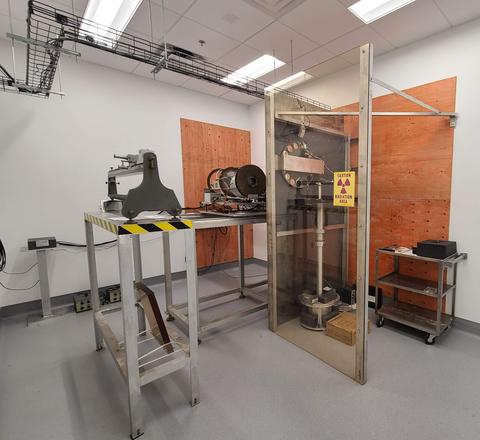Summary
Small radioactive "seed" sources used in prostate brachytherapy, containing the radionuclides 103Pd, 125I, or 131Cs, are calibrated in terms of air-kerma strength using the NIST Wide-Angle Free-Air Chamber (WAFAC). The WAFAC is an automated, free-air ionization chamber with a variable volume, allowing corrections to be made for passage of the beam through non-air-equivalent electrodes, which directly realizes the quantity air-kerma strength.
Description

Since 1999, over 1,500 seeds of more than 40 different designs from 18 manufacturers have been calibrated using the WAFAC. On-site characterization at seed manufacturing plants for quality control, as well as at therapy clinics for treatment planning, relies on well-ionization chamber measurements. Following the primary standard measurement of air-kerma strength, the responses of several well-ionization chambers to the various seed sources are determined. The ratio of air-kerma strength to well-chamber response yields a calibration coefficient for the well-ionization chamber for a given seed type. Such calibration coefficients enable well-ionization chambers to be employed at therapy clinics for verification of seed air-kerma strength, which is used to calculate dose rates to ensure effective treatment planning. To understand the relationship between well-ionization chamber response and WAFAC-measured air-kerma strength for prostate brachytherapy seeds, emergent x-ray spectra are measured with a high-purity germanium (HPGe) spectrometer. Knowledge of seed spectra allows separation of well-ionization chamber response effects due to spectrum differences from those due to seed internal structure and self-absorption, which influence the anisotropy of x-ray emissions from the seed. The relative response of calibration instruments has been observed to depend on such anisotropy. Seed manufacturers periodically send batches of three to five seeds to NIST for calibration. These seeds are then forwarded to several Accredited Dosimetry Calibration Laboratories (ADCLs) to establish and subsequently maintain the secondary standard at these laboratories for use in calibrating clinical well-ionization chambers. To ensure that seeds submitted for WAFAC calibration are consistent and representative of that particular seed design so that associated errors will not be propagated down the traceability chain to the ADCLs, seed manufacturers, and therapy clinics, several additional tests have been implemented. The distribution of radioactive material within a seed is mapped using radiochromic-film contact exposures. The in-air anisotropy of seeds is studied by taking WAFAC and x-ray spectrometry measurements at discrete rotation angles about the long axis and the axis perpendicular to the mid-point of the long axis of the seed, respectively. The "air-anisotropy ratio", calculated from the results of angular x-ray measurements, has proven to be a useful parameter for explaining differences in well-chamber response observed for different seed models having the same emergent spectrum on their transverse axis.

